Menu
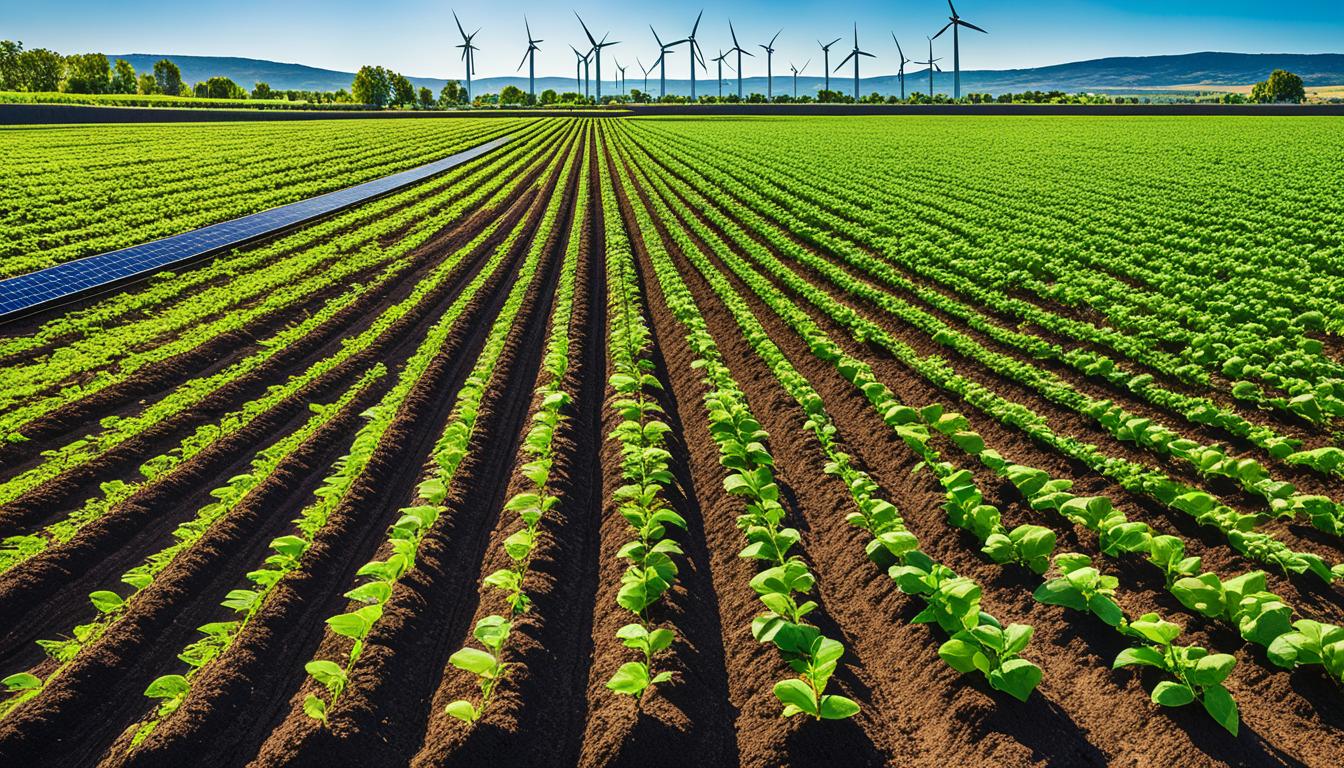
Did you know Trey Hill was paid $115,000 for storing 8,000 tons of carbon in his soil? The earth’s soil can be a huge weapon against climate change, soaking up CO2. The United States could cut 5% of its annual CO2 emissions thanks to soil sequestration. This shows how big an effect farming for carbon sequestration can have.
Carbon-smart farming is good for meeting food needs and fighting climate change. Farmers are key to keeping our soil healthy, which keeps our food safe. With the planet getting hotter, trapping carbon in soil is vital. It makes soil better, helps with water and keeps more plants and animals alive. This could bring a green change to farming.
Soil is a top player in fighting climate change, trapping carbon. It helps balance the extra CO2 humans put out. This is key because Earth faces a rise in CO2 emissions.
The link between soil and climate is strong. It’s critical to use soil well to make the most of its carbon-trapping power.
Our planet’s soils hold lots of carbon, more than the air or all living things. Yet, about a third of the world’s soil is not in good shape. But, we can make soil healthier and boost its ability to take in carbon. What’s exciting is that even a small increase in carbon in the soil, around 4‰, could eat up a big part of the CO2 we pump into the air each year. This is really promising, especially in places where farming needs a boost, like in Sub-Saharan Africa or South and West Asia.
Good soil health is key for trapping carbon. It also keeps water, air, and a lot of living things healthy. Making soil better at storing carbon helps fight climate change. Methods like less ploughing, planting cover crops, and adding organic matter help a lot. They boost the amount of carbon soil can hold.
Working on soil health helps grow more food, too. It shows how closely farming and the environment are linked.
In the EU, forests and other natural areas took in lots of CO2. They helped lower the region’s emissions by about 7%. This shows soil is a major force in holding back climate change. Protecting and improving soil is crucial for a safer planet.
It’s essential to switch to sustainable farming for better carbon sequestration. These farming methods cut down on harmful gas emissions. They also make the land healthier and more productive. By far, the best methods include regenerative farming and using organic stuff to enrich the soil.
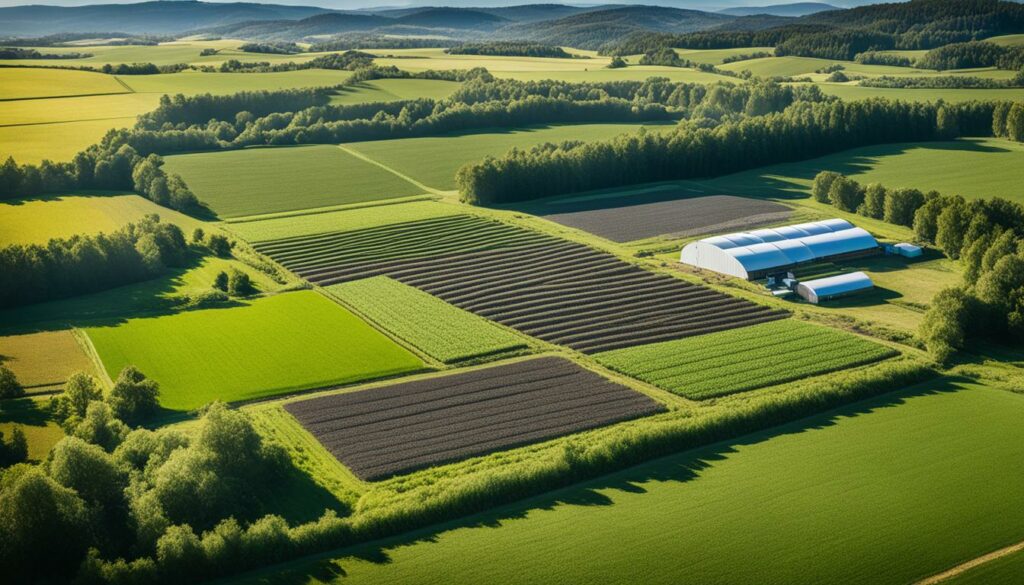
Regenerative farming is all about making soil healthy again for storing carbon. Cover cropping stands out for adding crucial organic matter to the soil. This helps with carbon storage. Using plants that live for many years helps too. They have deep roots, which store carbon and make the soil better.
Not turning over the soil (no-till) keeps it solid and cuts down on soil washing away. Plants and trees together (agroforestry) also grab carbon from the air. Their roots and leaves make the soil richer and store more carbon.
Adding natural matter to the soil is key for sustainable farming. Compost boosts the organic stuff in the soil. This encourages good bacteria and increases carbon storage. Another good thing to add is Biochar. It helps the soil hold on to nutrients and supports the life of helpful microbes. This is great for long-term farming that’s kind to the earth.
| Technique | Benefits |
|---|---|
| Composting | Enhances soil organic matter and promotes microbial activity |
| Biochar | Improves soil nutrient retention and supports microbial life |
Governments are helping too. They offer advice and money for these eco-friendly farming ways. These methods don’t just make farms more productive. They also help farms deal better with changing climates. This balanced way of farming takes care of the land and those who rely on it in the long run.
To improve soil health and fight climate change, a key step is using effective carbon sequestration farming techniques. Practices like reduced tillage and cover cropping stand out.
Reduced tillage keeps soil structures strong, stops erosion, and keeps carbon in. It means disturbing the soil less. This helps store more organic matter, boosting the soil’s ability to hold carbon. It also helps soil microbes stay healthy, aiding in carbon storage.
Cover cropping plays a similar vital role. It involves planting certain crops in between main crops to shield the soil from damage, keep moisture in, and make the soil livelier. Plants like clover and rye bring in good microorganisms. They help move nutrients around and lock more carbon in the ground.
| Techniques | Benefits |
|---|---|
| Reduced Tillage | Minimises erosion, conserves soil structure, enhances carbon retention |
| Cover Cropping | Protects soil from erosion, improves moisture levels, boosts biodiversity |
Using these farming methods is a strong way to make the soil and the planet healthier. Both reduced tillage and cover cropping show us how much effect simple farming changes can have on storing carbon.

Over 12,000 years of farming, the earth has released 133 billion metric tons of CO2. This fact makes clear the urgent need for techniques to store carbon in the soil. Both old methods like composting and newer ways like using biochar are important.
Carbon sequestration methods have the potential to make a big difference. By 2030, they could prevent about 5.3 GtCO2 from getting into the air every year. Yet, due to bad farming practices, some soils have lost 70% of their original carbon. This shows that we must act quickly to keep our soil healthy.
Although these methods could store a lot of carbon, their wide use might not be easy. A major challenge is the cost. The cost-effective use of these methods could save about 3.8 GtCO2 yearly. But to make this happen, we need to improve carbon pricing. This would make storing carbon in the soil more attractive to everyone.
About 80% of the world’s carbon that’s outside the sea, nearly 2500 gigatons, is in the ground. This is more than what’s in the air. Organic carbon accounts for 1550 gigatons of this, while 950 gigatons are inorganic. So, making our soils richer in organic matter is key.
“Biological methods such as reforestation, sustainable forest management, and agroforestry present effective, low-risk carbon sequestration methods,” says the American Society of Civil Engineers (ASCE). Embedding these methods in farming can bring big changes.
The U.S. is working towards better ways for farmers to sell carbon credits. This will help rented lands too. Considering that nearly 40% of U.S. farmland is rented, it’s important.
By investing in soil carbon storage enhancement, farmers can fight climate change and improve their land. These efforts boost soil health, water retention, and prevent damage. Knowing about these methods helps us all move toward a more sustainable way of farming.
| Technique | Benefit |
|---|---|
| Biochar Application | Increases carbon storage, improves soil fertility |
| Composting | Enhances soil organic matter, nutrient content |
| Cover Cropping | Reduces erosion, improves soil moisture levels |
| Reduced Tillage | Conserves soil structure, minimises erosion |
We all have a part in using carbon sequestration methods to help our planet. By working together, we can create a healthier earth and reduce the impacts of climate change.
Composting is a key method for storing carbon, helping the earth in two ways. It keeps carbon in the ground and makes the soil healthier. Places like California, which grows lots of food, use compost a lot. Besides boosting the economy, compost helps the environment by keeping water and air clean.
By composting, we turn waste like manure into food for the soil. This enriches the earth, allowing it to hold more carbon. It’s a great way to trap carbon and reduce harmful gas in the air. Tests show that one composting session can keep storing carbon for many years.
Farmers also benefit a lot. They earn money through carbon credits. This extra income helps them switch to greener farming.
| Statistics | Data |
|---|---|
| Percentage of Produce | Nearly 50% |
| Water Usage in Central Valley | Approx. 80% |
| GDP Representation | 2-3% |
Composting doesn’t just store carbon. It also makes soil better. Healthier soil means more life beneath the surface. This makes nature stronger against climate change.
Studies show that adding compost to grasslands helps fight climate change and keeps the land fertile.
In places like California, putting compost on the land can store more carbon and cut down harmful gases. Projects like the Marin Carbon Project prove this by making the land produce more and store more carbon.
There are challenges in using more compost, like cost. But researchers are working hard to show the real benefits. This will help more people see why we should use more compost in farming.
Carbon offset farming is changing with new methods. It’s using Enhanced Mineral Weathering (EMW) to absorb and store CO2 better. This method uses rocks in the soil to speed up the process. It’s good for the planet and changes how farmers work.
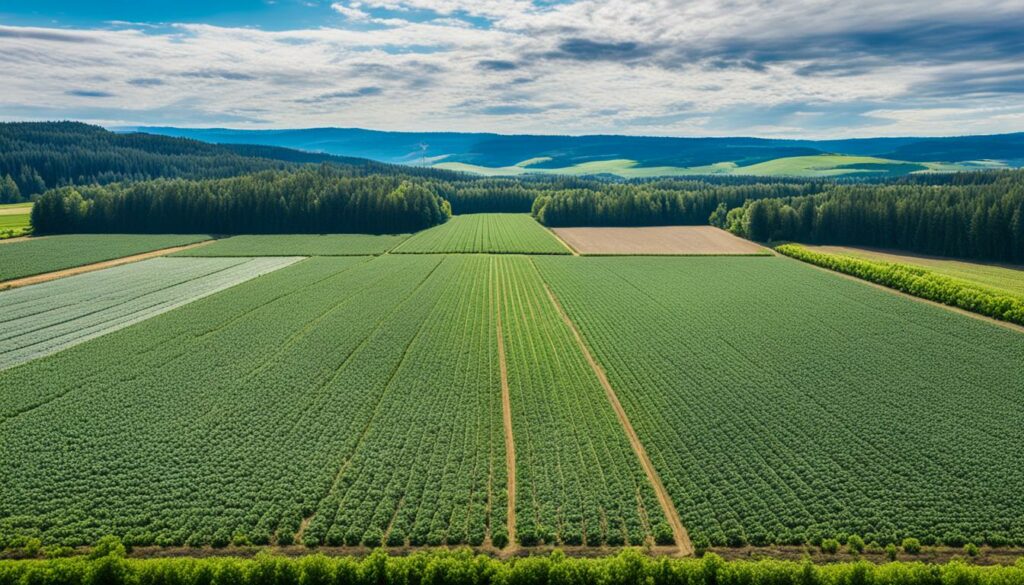
Many groups support these new ways of farming. The LIFE programme helps 700 farms in Europe to cut their carbon output by 15%. Also, the European Regional Development Fund runs a €1.8 million project (2023-2026) with nine countries and eleven partners. They’re all working towards a greener future.
These efforts fit with the EU’s goals to fight climate change. The Common Agricultural Policy and Horizon Europe work to reduce carbon and improve farming. Just like the New European Bauhaus aims to build with the planet in mind, so can farmers. They can use these methods for lasting benefits.
The EU CRCF Regulation is a big deal too. It sets rules for how carbon farming is checked and certified. This makes sure the work is high quality and transparent. The goal is to help the environment and ensure everyone plays fair.
The European Green Deal wants to be carbon neutral by 2050. To get there, we need farm projects like the ones by the European Bioeconomy Network. They’re working on over 150 plans to make farming good for us and the planet. These efforts will help the soil, keep our food steady, and make our economies stronger, helping everyone.
Over 12,000 years, agriculture released 133 billion CO2 tons. This shows farmers’ influence on soil carbon. It’s over three times what all humans emitted in 2019.
In some places, cultivated soils lost up to 70% of their organic carbon. This proves we need good agricultural carbon sequestration strategies to keep soil carbon levels up.
The IPCC says we could lower CO2 levels by 5.3 GtCO2 by 2030 through soil carbon sequestration. But, between 2000 and 2010, agriculture itself put out 5.0-5.8 GtCO2. So, better ways could make a big impact.
Farmers are at the heart of making a difference. Good practices, like planting the right crops, using fertilisers carefully, and managing water well, help store more carbon in the soil. This makes the soil healthier.
Making carbon sequestration techniques work well can remove 3.8 GtCO2 yearly, costing $100 per CO2 ton. But, in the U.S., carbon credits sell for much less, between $15 and $20. This gap shows a need for change.
Not all farm methods are the same. The best agricultural carbon sequestration strategies change based on where you are and the issues you face. Using new technologies and ideas can make farmers more effective and sustainable.
The Growing Climate Solutions Act helps farmers enter carbon markets. This could especially help the 40% of U.S. farmland that is rented and struggling. It’s a step towards a more sustainable future.
It’s key to know how farming impacts soil carbon, especially as we push for carbon neutrality. Efforts by groups like the Working Lands Innovation Center, trying out different soil-improving methods, are crucial. They help us find the best ways to farm for the planet.
Using practices like compost and agroforestry offer a bright future for farming. These not only store more carbon but also make the soil and farms better, stronger, and more productive. It’s about a future in farming that makes sense for everyone.
Regenerative farming is a key player in the fight against climate change. It enhances soil’s ability to capture and store carbon. This boosts farm productivity while helping the planet. Adding trees to fields and mixing in livestock can greatly increase how much carbon the land holds. This is good for both the earth and farmers’ incomes.
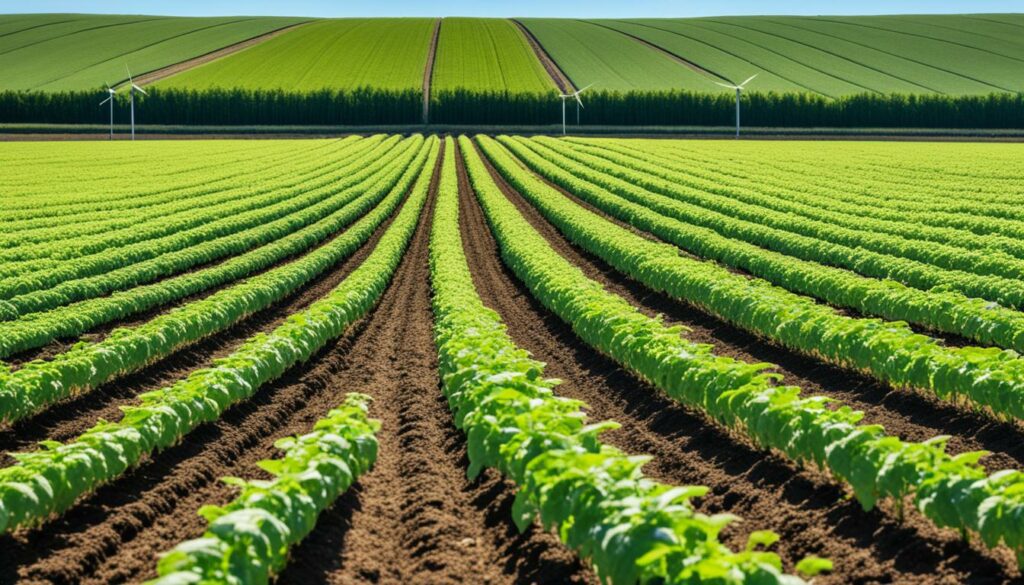
Agroforestry mixes trees with crops and animals, enhancing the land’s health and storing more carbon. This practice increases biodiversity and income sources, making farms more resilient to changing climates. Over 24 million hectares around the world are better off thanks to agroforestry. It makes a big difference.
Integrating animals into farming helps balance the ecosystem. Through careful grazing and looking after pastures, livestock can help store more carbon in the soil. In Zambia, new methods have boosted soil health, locked in more carbon, and made farms better at handling droughts.
Well-respected experts agree on regenerative farming’s potential. Dr. Rattan Lal sees it could lock away 178 billion tons of CO2 by 2100. The Rodale Institute believes it could even offset all of the CO2 emissions produced every year. This shows how powerful regenerative agriculture can be.
Today, many see carbon credits as a smart way to encourage farming that traps carbon. This kind of farming helps cut down on harmful gases. It also means big money for farmers. To take part, understanding the carbon market dynamics is key.
There are two kinds of carbon markets: those that are mandatory and those that are chosen by groups or individuals. The first type is overseen by the government, which sets limits on emissions. The Growing Climate Solutions Act, for example, affects these rules. In contrast, in voluntary markets, companies and people can use creative, market-based plans to lessen their emissions. A U.S. Department of Agriculture report pointed out the value of carbon credits as special incentives for farmers who grow carbon-sequestering crops.
Small farmers can do very well in the carbon market. Thanks to the Inflation Reduction Act, demand for their eco-friendly farming practices has tripled. Also, groups like ACORN give them tools and know-how. This helps them enter new markets.
| Statistic | Value |
|---|---|
| USDA Investment for GHG Measurement | $300 million |
| Funding from Inflation Reduction Act | $20 billion |
| States in Indigo’s Service Area | 28 |
| Minimum Payment per Carbon Credit | $20 |
Technology plays a crucial role in improving our understanding of soil. This knowledge helps enhance agriculture and protect the environment. It provides accurate data on soil health, influencing the choices farmers make.
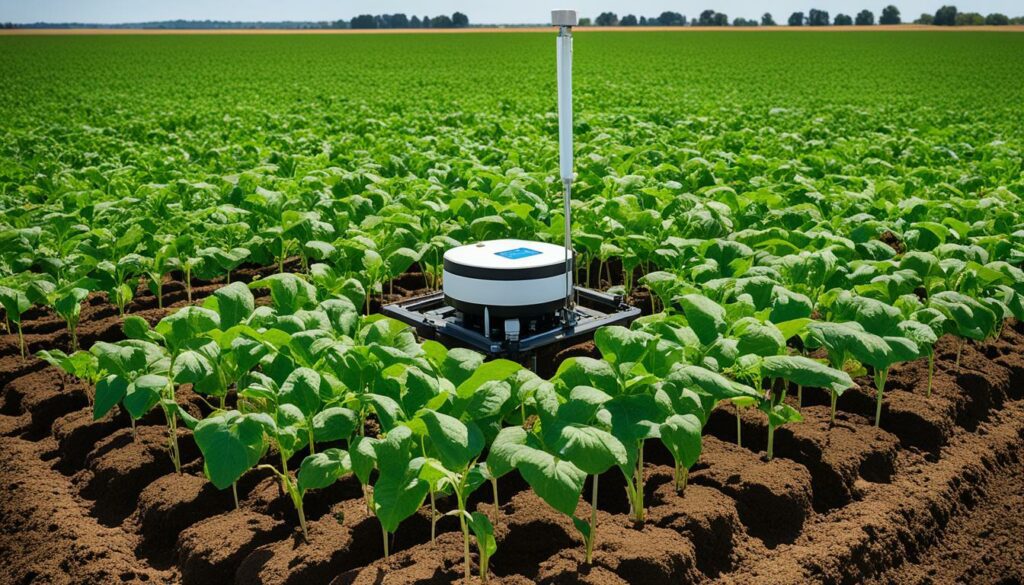
Advanced tools allow us to measure soil health precisely. We can check the soil’s ability to hold carbon, its nutrient content, and if it has harmful pathogens. This detailed information helps in managing the soil better.
Farmers can now adjust their farming methods based on detailed soil health data. This improves soil use, making it better for both productivity and the environment.
With detailed soil data, farmers can make better choices. They decide on compost, irrigation, and crops more accurately. This cuts wastage and boosts harvests. It’s key for successful farming and keeps soil healthy while saving carbon.
Modern technology not only makes farming more efficient but also greener. It’s part of efforts to reduce carbon in the atmosphere. As tech gets better, it will keep helping us farm in ways that are good for the earth.
| Technological Benefits | Impact on Soil Management |
|---|---|
| Accurate Soil Health Measurement | Informed decision-making for fertiliser and compost use |
| Pathogen Detection | Targeted disease control measures |
| Nutrient Analysis | Optimised crop selection and growth conditions |
| Carbon-Holding Potential Assessment | Enhanced strategies for boosting carbon sequestration |
Agriculture is now key in fighting climate change. By using various methods, it cuts down on greenhouse gases and helps farming last for the long term. This focus makes farmers more important in the battle against climate change.
Reducing greenhouse gases is a top goal. For example, not tilling the soil can store more carbon and lower emissions. Manage nitrogen well to reduce nitrous oxide, which is very bad for the climate.
Efficient use of nitrogen is also important. Partnerships with livestock help lower methane. And using methods like composting makes the soil healthier and the water cleaner.
Long-lasting farming methods are the aim. Cover crops, buffer strips, and less tilling add to the soil’s carbon and health. Wind barriers help keep carbon in the soil and clean the air.
Composting enriches the soil for better crops over time. Good care of livestock fits in well with these methods. The goal is to make food production and farming a positive force for the planet. This approach is big in reducing the world’s carbon impact.
| Practices | Benefits |
|---|---|
| No-Till | Enhances soil carbon sequestration and reduces emissions |
| Contour Buffer Strips | Increases carbon sequestration and improves soil health |
| Proper Nitrogen Management | Reduces nitrous oxide emissions |
| Livestock Partnerships | Reduces methane emissions |
| Composting | Improves soil organic matter |
| Cover Cropping | Increases carbon stocks, reduces soil compaction, and improves soil health |
It’s vital to adopt these farming methods and tech to sustain agriculture and fight climate change. By changing how we produce food, we address the environment’s needs and build a future that’s both strong and green.
.
Collaborative farming is changing how we take care of the land. It involves many groups like researchers, farmers, startups, and Indigenous people. Together, they work to store more carbon in the soil. This helps in active farms and areas not currently in use.
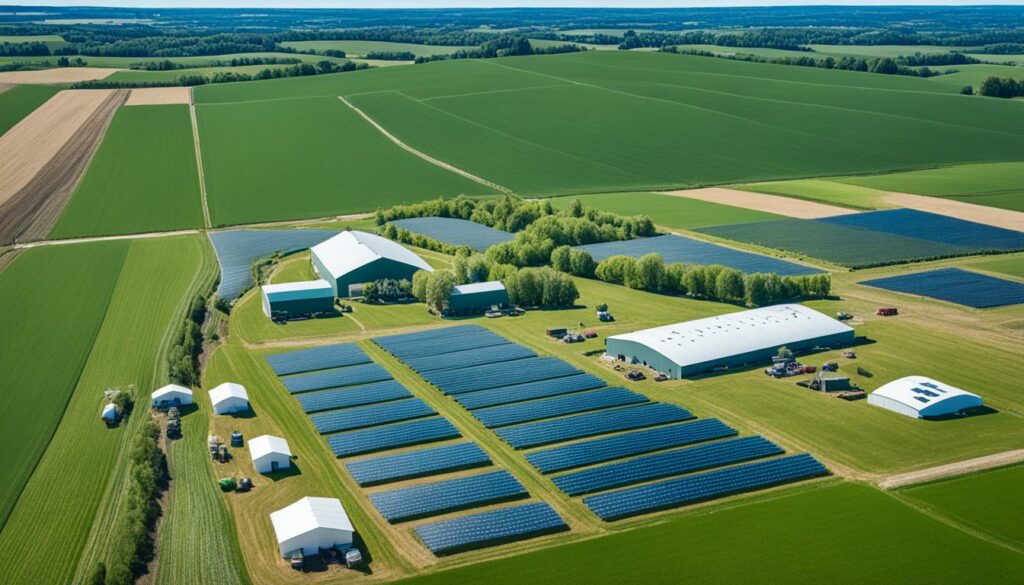
Farmers around the world are now using smart farming methods to fight climate change. They grow cover crops, practice no-till farming, and combine trees with pastures. These methods not only capture carbon but also improve the soil and its health.
Support from governments and groups is key to making these changes happen. They help by offering knowledge, funds, and tools. Thanks to these aids, farmers can use eco-friendly ways that benefit the planet.
Now, farmers can make money by saving the planet. They do this by storing carbon and selling carbon credits. This new approach shows that making money and protecting nature can go hand in hand.
Studies prove that these approaches work in the real world. The Soil Organic Carbon network (SOCnet) shows how farming affects the amount of carbon in the soil. It uses years of data from farms to understand what works best.
| Practice | Benefit | Implementation Support |
|---|---|---|
| Cover Cropping | Enhances soil structure and sequesters carbon | Technical assistance, funding |
| No-till Farming | Minimises erosion and retains soil carbon | Funding, resource allocation |
| Agroforestry | Increases biodiversity and soil carbon | Resource allocation, technical guidance |
| Biochar Application | Enhances nutrient retention, sequesters carbon | Technical guidance, research support |
By coming together in farming practices, we can make our agriculture better and fight climate change. These efforts show the powerful impact of working together for a greener world.
Agricultural carbon sequestration shows huge potential, despite facing big challenges and hurdles. Moving forward means dealing with these difficulties while also embracing new openings.
It’s important to understand the hurdles in agricultural carbon sequestration. For example, strict rules can limit how much farmers can do. The cost of starting these practices can also be a major problem.
Measuring the benefits from these actions can be complex. This can make farmers hesitant to start or continue.
But, there is hope for the future of farming and carbon storage. Ongoing research and new tech can help beat these challenges. Plus, getting support from different groups and markets for carbon could help a lot.
This support can lead to major progress. It would let farmers worldwide help fight climate change. It would also support a long-term future for agriculture. Methods like no-till and conservation tillage are already showing they work. So, the future looks bright for these efforts.
UC Davis is at the forefront of carbon sequestration farming. This is crucial in the global battle against climate change. The university shows true environmental leadership. It combines knowledge from different fields. These include environmental studies and health sciences. This mix leads to big steps in capturing carbon.

UC Davis leads with its Working Lands Innovation Center. Here, it works with others to test carbon capture methods. This puts UC Davis in the lead of carbon sequestration projects. The university also supports sustainable farming. It runs programs mixing the latest science with farm practices. This helps with effective climate actions.
The Nature Based Solutions for Climate Change Programme has invested £12.5 million. It supports projects like the Wild Exmoor Carbon Sequestration Project. This got £962,084 in funding. Another is the Severn Solutions for Nature’s Recovery. It received over £417,000. Projects like Plymouth’s Natural Grid also got funds. It received about £1 million. These actions show a big effort in fighting climate change through nature.
| Project Name | Funding Amount |
|---|---|
| Wild Exmoor Carbon Sequestration Project | £962,084 |
| Severn Solutions for Nature’s Recovery | £417,000 |
| Plymouth’s Natural Grid Nature Based Solutions for Climate Change | £1 million |
| Derwent Forest Landscape Recovery Project | £645,000 |
| Oxfordshire–Buckinghamshire Freshwater Network | £780,000 |
In the end, UC Davis’s work in carbon sequestration is key. It shows their strong commitment to sustainable farming. This sets an important example for environmental care and fighting climate change in farming.
Looking at successful carbon sequestration projects offers important lessons. It shows how we can capture carbon in farming. For example, the Carbon Farming Program in Western Australia is a great model. This programme had 6 projects in its first phase, covering 5,807 hectares. Their goal was to remove about 406,000 tonnes of carbon dioxide over 25 years. In the second phase, they supported 10 projects that aimed to take out 423,000 tonnes of CO2 from 8,333 hectares. These examples show how impactful well-planned carbon farming projects can be.
The Lemonade Valley Biodiversity Project is interesting too. It is expected to create 29,164 ACCUs – a measure of carbon saved – by planting trees on 200 hectares. The funding it got was $397,950. Another great project is the Hacienda De Trigo one. It plans to make 84,543 ACCUs by planting trees and working on the soil across 1,507 hectares. It received $140,000 in funds. These projects prove there are many ways to store carbon effectively.
The Dirty Clean Food – Regenerative Farmer Tree Project is also making a big difference. It’s expected to create 39,567 ACCUs by planting trees on 197 hectares. It got a funding of $174,533. Then, we have the Red Gully Farm Carbon Project, which is working on 975 hectares with $150,000. It aims to create 99,136 ACCUs. Each of these efforts shows how different methods, from planting trees to special soil work, can boost carbon storage. Their benefits go beyond reducing carbon. They also improve soil and farming.
All these examples are key for future plans. They help us understand what works in carbon farming. By learning from their successes, we can adopt better ways to capture carbon and fight climate change. These models lead the path towards more sustainable farming and significant cuts in climate effects.
Carbon sequestration farming collects and stores carbon in the soil. This helps fight climate change. It also boosts soil quality, water holding, and the number of species. This is great news for the planet and our food supply.
Soil acts as a carbon sink by soaking up carbon dioxide from the air. It traps this carbon in the ground. This lessens the amount of harmful gases in the atmosphere, which is key to fighting climate change.
Good soil is vital for locking away carbon well. It has more organic stuff and tiny life forms that can help. Healthy soil is also linked to growing lots of food and the environment’s ability to recover from change.
Cover cropping, not ploughing too much, having trees in farms, and mixing in animals makes the soil healthier. These ways help the soil keep more carbon. They also help wildlife and make farms stronger against a changing climate.
Adding things like compost to the soil boosts its nutrients. This makes it better at keeping carbon. These methods are good for farming and make the soil rich and alive.
Less ploughing keeps the soil’s structure strong. It cuts down on soil loss and helps the ground keep more carbon. It makes soil healthier by keeping more natural stuff in it.
Growing plants that cover the soil stops it from being washed or blown away. It keeps the soil full of moisture and life. This helps the soil lock away more carbon, which is good for fighting climate change.
Making compost, using things like biochar, and adding other natural things can help. More natural materials in the soil means more places to hide carbon. This leads to better soil, more water saved, and less climate-changing gases in the air.
Composting turns trash into treasure for the soil. It feeds the ground and helps it hold onto carbon. This also helps hidden wildlife thrive, making the land stronger against tough weather.
A smart-sounding way called Enhanced Mineral Weathering speeds up how fast rocks eat up carbon. It makes the soil and our food better. Plus, it brings extra money to farmers and helps more plants and animals live happily.
By picking certain crops, being careful with fertilisers, and smart watering, farmers can hold more carbon in the soil. New tools let them do this in a good way. This makes farming help the planet more.
Farming that lets trees and animals help out stores a lot of carbon. It saves the planet and makes farms richer. It’s a way of farming that’s good for everyone, including all kinds of life.
Carbon credits are like gold stars for taking good care of the environment. By earning them, farmers get money and make their farms safer from climate change. It’s a win for the earth and for the farmers.
Cool tools can see how healthy the soil is and what it needs. This info guides farming choices that keep more carbon safe. It makes growing food friendlier to the planet.
Smart farming, with things like cover crops and mainly plant-based ways, cuts down on harmful gases. It makes farms into places that take in more carbon. This lowers the earth’s overall pollution.
Working together with farmers, scientists, and people in the community brings new ideas for storing carbon. With strong support, farmers can make their land take in more carbon and help with the big issue of our time.
There are hurdles like hard rules, needing investments, and tricky measurements. But, with research, technology, and lots of help, farmers can do a lot to fight climate change. They have a big role to play.
Places like UC Davis are top in finding ways to store carbon in farming. They’re doing big projects to show how we can farm, find food, and protect the earth all at once. Their work is leading the way in farming for our future.
There are many stories of success, like using compost well and making rocks eat more carbon. These projects help the earth and make farming better. They are examples of how everyone can help the planet.